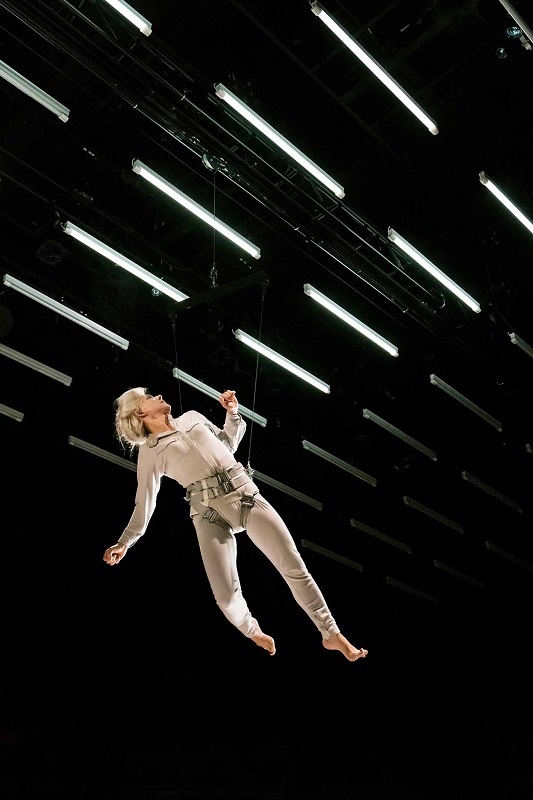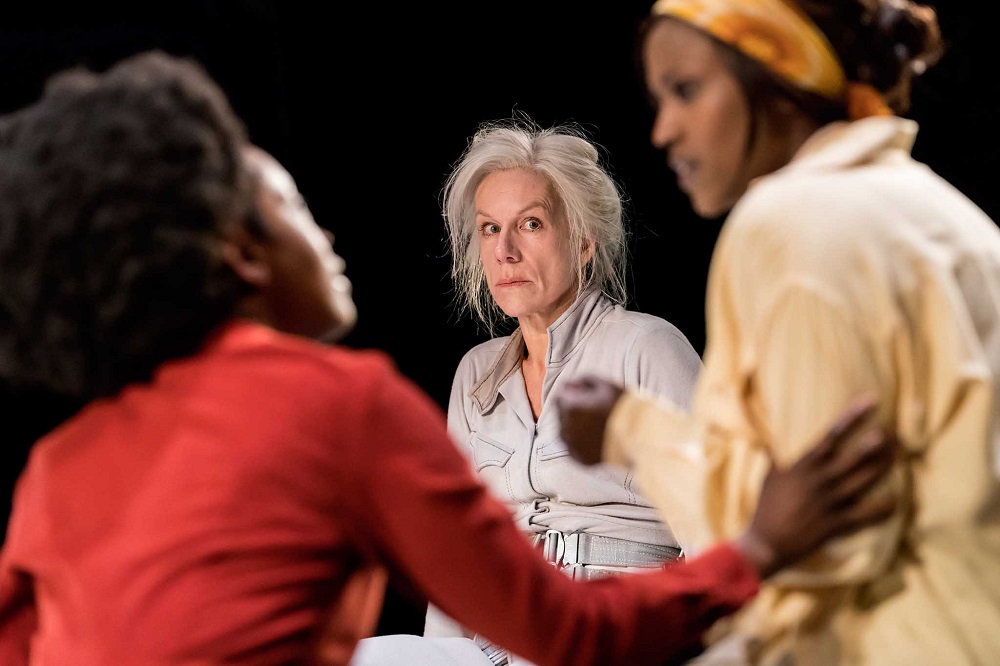Wings, Young Vic review - Juliet Stevenson goes high and low | reviews, news & interviews
Wings, Young Vic review - Juliet Stevenson goes high and low
Wings, Young Vic review - Juliet Stevenson goes high and low
Arthur Kopit's poetic drama about post-stroke aphasia and facing up to death astounds

Now look here, Giles Coren: immersion in a great play well acted can send you out of the theatre feeling very different from when you entered it – and I don’t mean stressed-out. In this case, light as air and sad as hell, simultaneously. You may still find it funny or contrived.
Whether everyone responds to a bold experiment as tearfully as I did may depend partly on experience of what havoc a stroke can wreak on a person and his or her family. But theatrical alchemy is about more than simply registering the situation – which Kopit also did in a moving long introduction reproduced in the Young Vic’s programme-text. He recalls how the oldest of the three women he met could see summer outside the window, put all her might in a speech therapy session into coming out with the word “winter” to identify it, “looked over at where I sat and shook her head in dismay, then laughed and said ‘This is really nuts, isn’t it?’"
 The line goes into the play – originally a radio drama, powerfully adapted by Kopit for the stage – along with other seemingly ordinary sentences that may seem like nothing out of context but which cut to the quick (“I’ll come back to that”, “the death thing, it comes in… I can’t get it out till it’s ready”, “just can’t bring myself to give it up”). If you read the introduction, does the drama turn out surplus to need? Not at all; like all great art, it gives form and content to the full, dizzying experience from within and without. Stevenson’s Emily Stilson sees the medical staff around her, when they come into some kind of focus, as crazy, unable to understand what’s at first making sense in her head; but we also see how her speech appears to them.
The line goes into the play – originally a radio drama, powerfully adapted by Kopit for the stage – along with other seemingly ordinary sentences that may seem like nothing out of context but which cut to the quick (“I’ll come back to that”, “the death thing, it comes in… I can’t get it out till it’s ready”, “just can’t bring myself to give it up”). If you read the introduction, does the drama turn out surplus to need? Not at all; like all great art, it gives form and content to the full, dizzying experience from within and without. Stevenson’s Emily Stilson sees the medical staff around her, when they come into some kind of focus, as crazy, unable to understand what’s at first making sense in her head; but we also see how her speech appears to them.
Was it a mistake to embody the key element – the “wings” – in the production? The fact that Mrs Stilson, like one of her role models, was an aviator and wing walker could lead to facile metaphor; but this, too, is rich and ambiguous in Stevenson’s and Abrahami’s realisation. Haltered throughout, the protagonist can float and soar in her dreams (pictured above) but also be turned upside down in mid air, unable to touch the ground or reach reality. Having been marooned inside the central oblong stage while others try to get through to her from outside – she gives them the replies she thinks they want, but they hear something else – she’s also hovering outside it, attempting to plant her feet on the ground, in one seminal scene where a doctor (David Emmings) attempts to draw speech and identification from her. Who would have thought that as simple an object as a toothbrush could lead to such agonising drama?
Stevenson moves from the delirium of the catastrophe though detachment and lacerating anger to steady rooting, and in this Lorna Brown’s sympathetic speech therapist Amy – the first to call her “Emily” rather than “Mrs Stilson” – is an essential questioner; it’s typical of Kopit’s sensitivity that instead of showing us the heroine regaining knowledge of a plane on a visit to Rhinebeck with her son, he has her describe it to her new friend. Poignant humour surfaces between these two, and there’s a much-needed divertissement in a therapy session, with delicate cameos from Nicholas Gasson, Mary Sheen and Kelle Bryan (pictured below, with Brown, left, and Stevenson). Ultimately, though, this is more than just a drama about the difficult subject of aphasia, speech disorder. Ultimately it turns into a final monologue about what is perhaps the biggest issue of all for any dramatist: fear of death. And though in the initial catastrophe sequence I fretted that the sound design from Gareth Fry and Michael Levine's visuals might overwhelm the theme – Stevenson is miked, her usually ineffable multi-octaved delivery sometimes muddied – they have become essential companions by that point. We’re as reluctant to leave them behind as Emily is to enter something “empty, black and endless” if she flies away from “this one small silly street in this one, small town”. We leave, like her, on wings. And with immense gratitude to Kopit for providing, like Beckett, a truly great role for an older woman.
Ultimately, though, this is more than just a drama about the difficult subject of aphasia, speech disorder. Ultimately it turns into a final monologue about what is perhaps the biggest issue of all for any dramatist: fear of death. And though in the initial catastrophe sequence I fretted that the sound design from Gareth Fry and Michael Levine's visuals might overwhelm the theme – Stevenson is miked, her usually ineffable multi-octaved delivery sometimes muddied – they have become essential companions by that point. We’re as reluctant to leave them behind as Emily is to enter something “empty, black and endless” if she flies away from “this one small silly street in this one, small town”. We leave, like her, on wings. And with immense gratitude to Kopit for providing, like Beckett, a truly great role for an older woman.
The future of Arts Journalism
You can stop theartsdesk.com closing!
We urgently need financing to survive. Our fundraising drive has thus far raised £33,000 but we need to reach £100,000 or we will be forced to close. Please contribute here: https://gofund.me/c3f6033d
And if you can forward this information to anyone who might assist, we’d be grateful.

Subscribe to theartsdesk.com
Thank you for continuing to read our work on theartsdesk.com. For unlimited access to every article in its entirety, including our archive of more than 15,000 pieces, we're asking for £5 per month or £40 per year. We feel it's a very good deal, and hope you do too.
To take a subscription now simply click here.
And if you're looking for that extra gift for a friend or family member, why not treat them to a theartsdesk.com gift subscription?
more Theatre
 A Christmas Carol, Old Vic review – tidings of discomfort and noise
This venue’s annual festive classic is seasonally joyous, but its writing is frankly patronizing
A Christmas Carol, Old Vic review – tidings of discomfort and noise
This venue’s annual festive classic is seasonally joyous, but its writing is frankly patronizing
![The cast of [title of show] - only in musical theatre...](https://theartsdesk.com/sites/default/files/styles/thumbnail/public/mastimages/0X5A2776-Edit.jpg?itok=qtQn1evO) [title of show], Southwark Playhouse review - two guys and two girls write about writing, delightfully
Revival of New York show lifts the spirits
[title of show], Southwark Playhouse review - two guys and two girls write about writing, delightfully
Revival of New York show lifts the spirits
 ARK: United States V by Laurie Anderson, Aviva Studios, Manchester review - a vessel for the thoughts and imaginings of a lifetime
Despite anticipating disaster, this mesmerising voyage is full of hope
ARK: United States V by Laurie Anderson, Aviva Studios, Manchester review - a vessel for the thoughts and imaginings of a lifetime
Despite anticipating disaster, this mesmerising voyage is full of hope
 Wolves on Road, Bush Theatre review - exciting dialogue, but flawed plotting
New play about young black men and cryptocurrency is sadly predictable
Wolves on Road, Bush Theatre review - exciting dialogue, but flawed plotting
New play about young black men and cryptocurrency is sadly predictable
 Burnt Up Love, Finborough Theatre review - scorching new play
Super writing and acting jolts us out of complacency
Burnt Up Love, Finborough Theatre review - scorching new play
Super writing and acting jolts us out of complacency
 L’Addition, BAC review - top billing for physical comedy duo
The latest in Forced Entertainment’s 40 years of experiment is a thought-tickling farce
L’Addition, BAC review - top billing for physical comedy duo
The latest in Forced Entertainment’s 40 years of experiment is a thought-tickling farce
 Barcelona, Duke of York's Theatre review - Lily Collins migrates from France to Spain
The 'Emily in Paris' star surrenders to cliche - or does she?
Barcelona, Duke of York's Theatre review - Lily Collins migrates from France to Spain
The 'Emily in Paris' star surrenders to cliche - or does she?
 Guards at the Taj, Orange Tree Theatre review - miniature marvel with rich resonances
Rajiv Joseph’s play pitting beauty against duty gets an impressive staging
Guards at the Taj, Orange Tree Theatre review - miniature marvel with rich resonances
Rajiv Joseph’s play pitting beauty against duty gets an impressive staging
 The Buddha of Suburbia, Barbican Theatre review - farcical fun, but what about the issues?
Hanif Kureishi classic gets a compulsively comic makeover from Emma Rice
The Buddha of Suburbia, Barbican Theatre review - farcical fun, but what about the issues?
Hanif Kureishi classic gets a compulsively comic makeover from Emma Rice
 How To Survive Your Mother, King's Head Theatre review - mummy issues drive autobiographical dramedy
Lots of heartache, but a strange void where the heart of the play should be
How To Survive Your Mother, King's Head Theatre review - mummy issues drive autobiographical dramedy
Lots of heartache, but a strange void where the heart of the play should be
 Dr Strangelove, Noël Coward Theatre review - an evening of different parts
Kubrick’s humour doesn't always detonate as it should in Armando Iannucci's version
Dr Strangelove, Noël Coward Theatre review - an evening of different parts
Kubrick’s humour doesn't always detonate as it should in Armando Iannucci's version
 Reykjavik, Hampstead Theatre review - drama frozen by waves of detail
Richard Bean’s new play revisits the Hull fishing industry of the 1970s
Reykjavik, Hampstead Theatre review - drama frozen by waves of detail
Richard Bean’s new play revisits the Hull fishing industry of the 1970s

Add comment